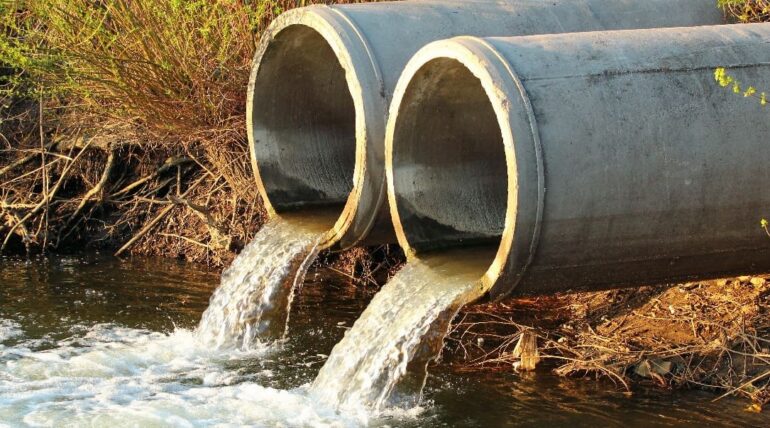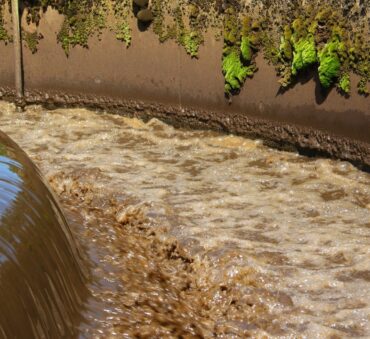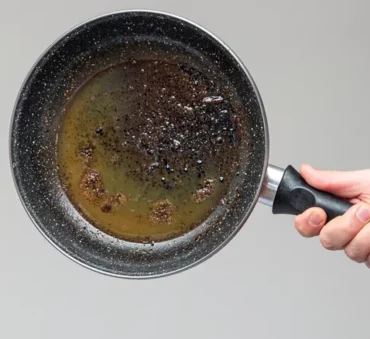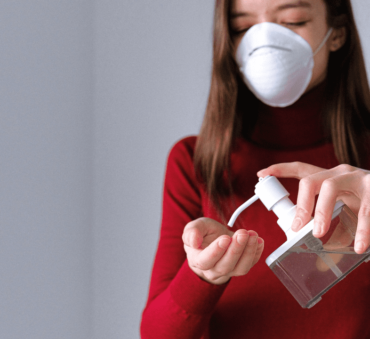Liquid waste (such as sewage and other wastewater) can be harmful to the environment and human health if not disposed of properly.
For example, in 2019, 80% of all hazardous waste was, in fact, wastewater.
To ensure its safe disposal, liquid waste must undergo various treatment processes. That’s where liquid waste management comes in. It ensures that liquid waste is converted into safe effluent that can be disposed of on land, at sea, or in rivers.
But what are the different types of liquid waste? What are the different treatment and disposal methods, and how to ensure your business is abiding by all liquid waste management best practices and regulations?
Read on to find out!
What is Liquid Waste?
Liquid waste refers to any type of waste in liquid form that contains pollutants or contaminants. For example, you have wastewater, sewage, and processed water from households, industries, and commercial establishments.
In the United States alone, wastewater treatment plants process about 34 billion gallons of wastewater every day.
To ensure this waste does not pose any harm to the environment, it needs to be properly managed to ensure its safe handling, treatment, and disposal.
But before we go into the details, let’s first outline the four main types of liquid waste.
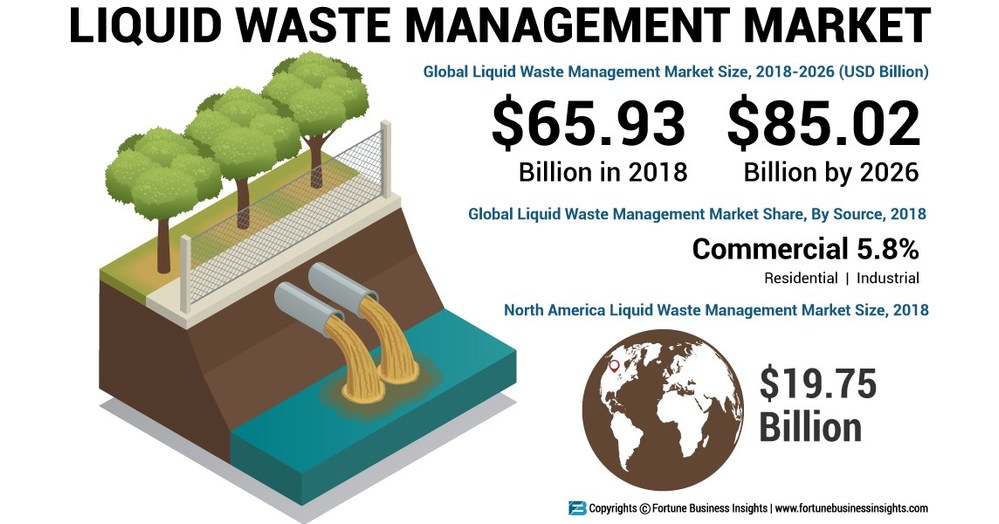
What are the Four Types of Liquid Waste?
There are a few different types of liquid waste, each with its unique characteristics. These are:
- Household liquid waste: This includes used cleaning products, expired beer, used cooking oils, detergents, and liquids from personal care items.
- Industrial liquid waste: Industrial processes generate a significant amount of liquid waste, such as wastewater from manufacturing plants, chemical spills, cooling water, used oil and various liquid byproducts.
- Agricultural liquid waste: Farming liquid waste mainly comes in the form of livestock wastewater, agricultural runoff, and excess irrigation water.
- Medical liquid waste: Medical facilities generate liquid biological waste, such as blood, bodily fluids, and expired medications.
So, what are the potential dangers associated with improper handling of these liquid waste types?
Dangers of Improper Liquid Waste Disposal
Improper disposal of liquid waste can pose serious negative consequences in terms of:
- Environmental hazards: When liquid waste is not disposed of properly, it can contaminate water sources (such as rivers, lakes, and groundwater). The harmful substances present in the waste can disrupt ecosystems and harm aquatic life. Additionally, contaminated water can pose a threat to drinking water supplies.
- Health risks: Improper handling and disposal of liquid waste can expose individuals to different chemical pollutants and toxins. This can lead to skin irritations, respiratory problems, and other adverse health effects. If contaminated water or soil enters our food chain, it can also pose other serious long-term health risks.
- Legal consequences: Regulatory establishments enforce various laws to ensure that liquid waste disposal does not harm the environment and public health. If you’re found to be in non-compliance, this can result in serious legal consequences, including fines, penalties, and potential legal actions.
What is Liquid Waste Management?
Liquid waste management involves handling, treating, and disposing of liquid waste in a safe way.
Its purpose is to protect ecosystems, prevent water pollution, and ensure public health. The benefits of effective liquid waste management include:
- Preserving freshwater resources
- Reducing the release of harmful contaminants in the environment
- Maintaining the safety of drinking water resources
Liquid Waste Management Methods
To achieve effective liquid waste management, organizations can adopt various liquid waste treatment and disposal methods.
Let’s cover the most popular ones:
Liquid Waste Treatment Methods
Liquid waste usually undergoes primary, secondary, and advanced treatment processes.
Preliminary Treatment Methods
This is the first step in liquid waste management. These methods aim to separate liquids from solids. Three methods can be used:
- Screening: Screening involves passing the liquid waste through filters to remove larger debris, such as sticks, plastics, or other solid objects.
- Sedimentation: This allows heavier solids to settle down at the bottom of a sedimentation tank while clearer liquid flows out for further treatment.
- Oil and grease removal: Liquid waste that contains oils and grease can be harmful to the environment. To remove these substances, specialists use methods like gravity separation or coagulant usage (both methods aim to separate the oils and greases from the liquid waste to allow for their easy removal).
Secondary Treatment Methods
These methods focus on the removal of organic matter and biological contaminants from liquid waste. Some commonly employed techniques are:
- Aerobic processes: Here, in the presence of oxygen, aerobic bacteria break down organic matter, reducing its concentration and removing contaminants. Examples of aerobic treatment include activated sludge and extended aeration systems.
- Anaerobic processes: Processes like anaerobic digestion and anaerobic lagoons are commonly used to decompose organic matter in the absence of oxygen. During this process, anaerobic bacteria break down organic waste. The byproduct of this reaction is biogas, which can be used as an energy source.
- Biofilters and bioreactors: These are employed to support the growth of microorganisms. In turn, the microorganisms metabolize and break down organic pollutants, improving the quality of the liquid waste.
Advanced Treatment Methods
These methods are applied only when further purification is necessary to meet specific regulatory requirements. Some examples include:
- Nutrient removal: This targets the reduction of nitrogen and phosphorus compounds in liquid waste. These compounds are removed since they can cause water pollution and harm aquatic ecosystems. Techniques like biological nutrient removal (BNR) and chemical precipitation are used to achieve this.
- Disinfection methods: Disinfection is the process of eliminating or reducing pathogens present in liquid waste to prevent the spread of diseases. Common disinfection methods include chlorination, ultraviolet (UV) disinfection, and ozonation.
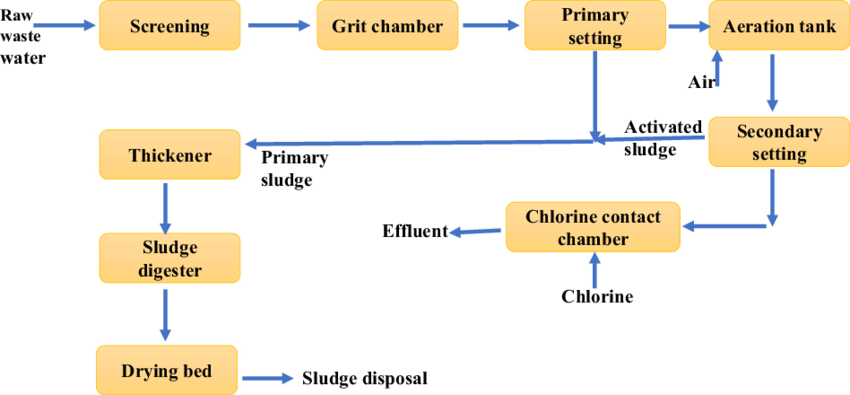
Liquid Waste Disposal Methods
Once the liquid waste has gone through treatment, it can be disposed of safely. Here are a few common disposal methods:
Traditional Disposal Methods
The most common traditional ways of disposing liquid waste include:
- Land application: This entails applying liquid waste to land (usually a smooth slope covered with grass). This can be used as a crop irrigation method or as a nutrient source for soil.
- Ocean dumping: Historically used, ocean dumping involves discharging liquid waste into the ocean. However, this method has raised environmental concerns due to potential harm to marine ecosystems, and stricter regulations are now in place to minimize its use.
Modern Disposal Methods
A few more commonly used modern disposal methods include:
- Incineration: This involves combusting liquid waste at high temperatures. How does that work exactly? High-temperature treatment helps reduce the volume of waste and destroys harmful pathogens. But keep in mind that this also requires careful management to ensure proper treatment of resulting residues.
- Deep-well injection: This method involves injecting liquid waste deep into underground wells. However, it requires suitable geological conditions to ensure safety and prevent groundwater contamination.
- Recycling and reuse: Liquid waste recycling and reuse is a method used to convert waste into usable products. Technologies such as membrane filtration, reverse osmosis, and biological processes enable the purification and reuse of treated liquid waste, reducing the demand for freshwater resources.
U.S. Regulations on Liquid Waste Disposal
There are several laws and regulations that govern the proper disposal of liquid waste in the United States. Here are some of the main liquid waste disposal regulations:
- Resource Conservation and Recovery Act (RCRA): Administered by the Environmental Protection Agency (EPA), the RCRA establishes a framework for managing hazardous and non-hazardous solid and liquid wastes. It sets standards for the storage, transportation, treatment, and disposal of liquid wastes, ensuring their safe management.
- Clean Water Act (CWA): The CWA regulates the discharge of pollutants into U.S. waters, including liquid waste. It sets water quality standards, establishes permitting systems for wastewater discharges, and promotes the prevention and reduction of water pollution.
- Safe Drinking Water Act (SDWA): The SDWA ensures the safety of drinking water supplies. It sets standards for the treatment and management of liquid waste that may contaminate drinking water sources, protecting public health.
- Occupational Safety and Health Administration (OSHA) Regulations: OSHA regulations aim to protect workers from hazards in the workplace, including those associated with liquid waste. These regulations address safe handling, storage, and disposal practices to minimize occupational risks.
Best Practices for Liquid Waste Management
The way businesses and households handle liquid waste has a huge impact on the environment and public safety. That’s why it’s essential to adopt the best liquid waste management practices and dispose of such waste responsibly.
To ensure proper liquid waste disposal, you need to define the following procedures:
What is the procedure for disposal of liquid waste?
The proper disposal of liquid waste entails:
- Identifying the liquid waste type: First, you need to determine the type of liquid waste you’re dealing with. This will help you choose the appropriate disposal method.
- Separating non-hazardous and hazardous liquid waste: Next, you need to classify liquid waste based on its potential harm to the environment and human health.
- Complying with regulations: Finally, you need to select treatment and disposal methods that abide by all local liquid waste regulations and guidelines.
Where to dispose of liquid waste?
You can dispose of liquid waste in a few different places, including:
- Authorized facilities: Such facilities are equipped to handle and treat specific types of liquid waste. This is a good option if you can’t process the waste at your own facilities.
- Recycling centers: If your waste can be recycled, consider this option. Such centers can process liquid waste so it can be reused in an environmentally friendly manner.
- Professional waste management services: Alternatively, you can engage the services of a reputable waste management company like Shapiro. At Shapiro, we specialize in liquid waste disposal to ensure compliant and responsible handling. The best part? We can take over the whole process, so you can focus on your other business activities. Our expert team will handle everything from collections and logistics to treatment and disposal.

How to dispose of liquid waste?
You can use different disposal methods depending on the liquid waste type you’re handling. For example, you could adopt one of these practices:
- Dewatering: This method involves separating the liquid from the solid waste. This way, you can dispose of the solid waste in a landfill (if it’s non-hazardous).
- Root-zone treatment: This method is mostly used for treating household wastewater. It involves the traditional sedimentation treatment, but the liquid waste also goes through additional filtration processes that make it safe to release into the environment.
- Solidification: This involves adding different solidifying agents to liquid waste (like sawdust, lime ash, and gypsum). Once the waste is solidified, it can be sent to a landfill for disposal.
Let Shapiro take care of your liquid waste management for you. With our modern liquid waste solutions, we can handle all your waste disposal operations safely and responsibly. Get in touch today to learn more.
Did you know: In the brewing industry, outdated or unsellable beer is also classified as liquid waste. Proper disposal methods of this waste include recycling it into animal feedstock, land application, and anaerobic digestion to produce biofuels.
Frequently Asked Questions
Some common examples of liquid waste include: wastewater from households, industries, and commercial establishments. In addition, we have sewage, chemical and solvent liquids, pharmaceutical waste, oil and grease and agricultural runoff.
Liquid waste is also referred to as wastewater or effluent.
Yes, liquid waste can be recycled through various treatment processes.
For example, it can be treated at wastewater treatment plants, where it undergoes purification. This process removes its contaminants, so it can be reused for irrigation, industrial processes, or even for drinking water in some cases.
Depending on its type and requirements for treatment or disposal, you can store liquid waste in various places. For example, you have septic tanks, holding ponds, lagoons and tanks.
Dry waste refers to solid waste materials that do not contain liquid components (such as paper, plastic, metal, and wood). On the other hand, liquid waste consists of predominantly liquid substances that encompass different fluids, sludges, or semi-liquid materials.
The most common liquid waste is domestic wastewater generated from households. This includes water from kitchens, bathrooms, and laundry activities.
Inadequate liquid management can result in water, soil, and air contamination. This can have serious consequences, such as environmental pollution, health risks, and ecological damage. Proper management ensures the safe treatment, disposal, and recycling of liquid waste, minimizing its impact on the environment and public safety.
Baily Ramsey, an accomplished marketing specialist, brings a unique blend of anthropological insight and marketing finesse to the digital landscape. Specializing in educational content creation, she creates content for various industries, with a particular interest in environmental initiatives.
